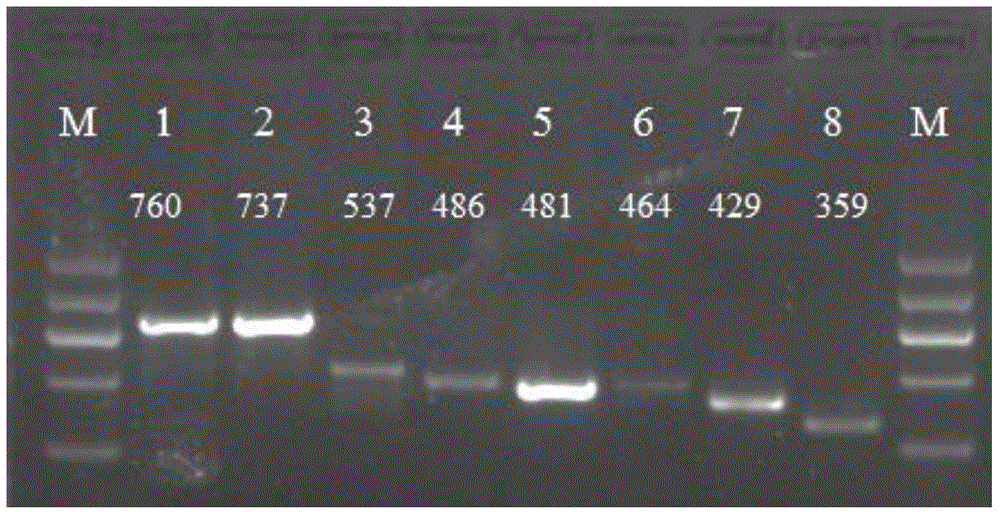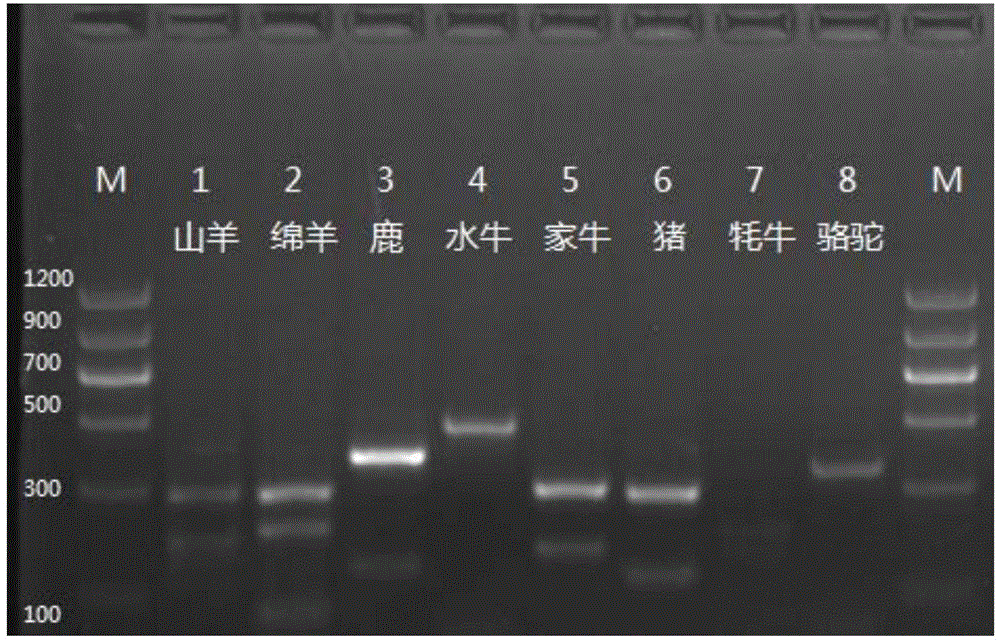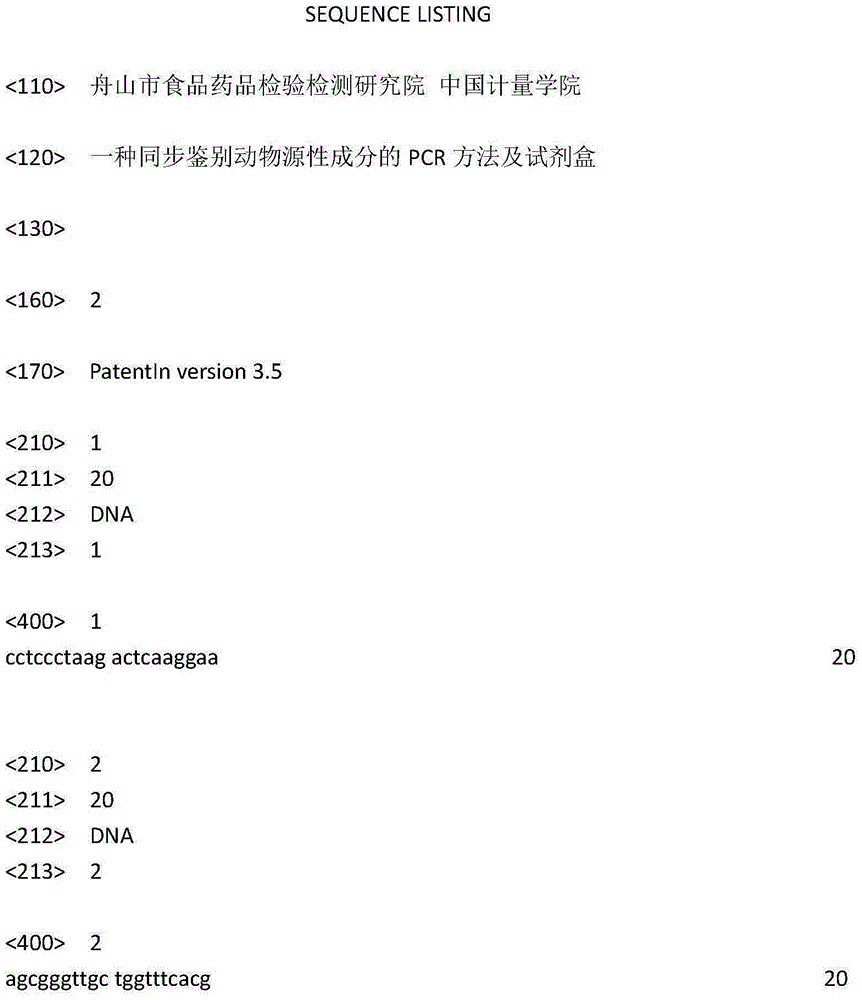PCR method and kit for synchronously identifying animal-derived ingredients
An animal-derived component, sheep technology, applied in the field of animal-derived component identification, can solve the problem of low specificity of multiple PCR technology that can only identify one species at a time, achieve good specificity and sensitivity, improve efficiency, The effect of improving detection efficiency
- Summary
- Abstract
- Description
- Claims
- Application Information
AI Technical Summary
Problems solved by technology
Method used
Image
Examples
Embodiment 1
[0026] Example 1 Primer Design
[0027] According to the gene sequence published by GenBank, the mtDNA of goat (GU229278), deer (HQ191428), buffalo (AF702618), cattle (EU177861), sheep (KF938337), yak (KM233416), pig (AF486867) and camel (AP003423) The whole sequence was used as a template, and the mtDNA sequences of 8 species and common species (chicken, duck, rabbit, mouse, horse, dog) were compared and analyzed. According to the specificity and conservation of their gene sequences, Primer premier 5.0 software was used to design A universal primer for multiple species, the primer is paired with the mtDNA sequences of the above-mentioned 8 species of goat, sheep, buffalo, domestic cattle, pig, deer, camel and yak. The primer sequences are as follows:
[0028] Universal downstream primer (SEQ ID NO: 1): AGCGGGTTGCTGGTTTCACG,
[0029] Universal upstream primer (SEQ ID NO: 2): CCTCCCTAAGACTCAAGGAA.
Embodiment 2
[0030] The optimization of embodiment 2 PCR reaction system
[0031] The PCR reaction system uses 20 μL of the basic system, including 2.0 μL of Buffer buffer, 0.2 μL of SEQ ID 1 and SEQ ID 2, 1.6 μL of dNTP mix, and 1.6 μL of MgCl 2 Buffer, 3.0 μL genomic DNA extraction solution (about 30ng DNA), 0.2 μL Taq DNA polymerase, and finally add water to make up to 20 μL.
[0032] According to the above PCR system, a temperature gradient was set on the gradient PCR instrument to optimize the annealing temperature (temperature range 45.0-65.0° C.). The basic PCR process is as follows: denaturation at 95°C for 5 min; denaturation at 95°C for 40 s, different annealing temperatures for 30 s, and extension at 72°C for 40 s as a cycle, a total of 30 cycles; then extension at 72°C for 10 min.
[0033]The PCR products at different temperatures were detected by electrophoresis (4S Red agarose nucleic acid dye), and the temperature with the best electrophoresis results was selected as the te...
Embodiment 3
[0036] Example 3 Enzyme digestion identification of PCR products
[0037] In order to better distinguish the 8 species in the present invention, especially goats and sheep, buffaloes, yaks and domestic cattle with similar PCR product sizes, the inventors compared the amplified sequences and used biological software to find suitable internal Finally, SspI endonuclease was selected to digest and identify PCR products. The results showed that after digestion, PCR products of different species produced fragments of different sizes. Goat PCR products were divided into four fragments of 291bp, 192bp, 160bp and 118bp; sheep The PCR product was divided into 300bp, 213bp and three 75bp fragments after enzyme digestion; the deer PCR product was digested to produce two fragments of 391bp and 146bp; the buffalo and camel PCR products had no cutting point, so the original size of 486bp and 359bp were retained respectively; The bovine PCR product has two fragments of 303bp and 178bp after d...
PUM
 Login to View More
Login to View More Abstract
Description
Claims
Application Information
 Login to View More
Login to View More - R&D
- Intellectual Property
- Life Sciences
- Materials
- Tech Scout
- Unparalleled Data Quality
- Higher Quality Content
- 60% Fewer Hallucinations
Browse by: Latest US Patents, China's latest patents, Technical Efficacy Thesaurus, Application Domain, Technology Topic, Popular Technical Reports.
© 2025 PatSnap. All rights reserved.Legal|Privacy policy|Modern Slavery Act Transparency Statement|Sitemap|About US| Contact US: help@patsnap.com



